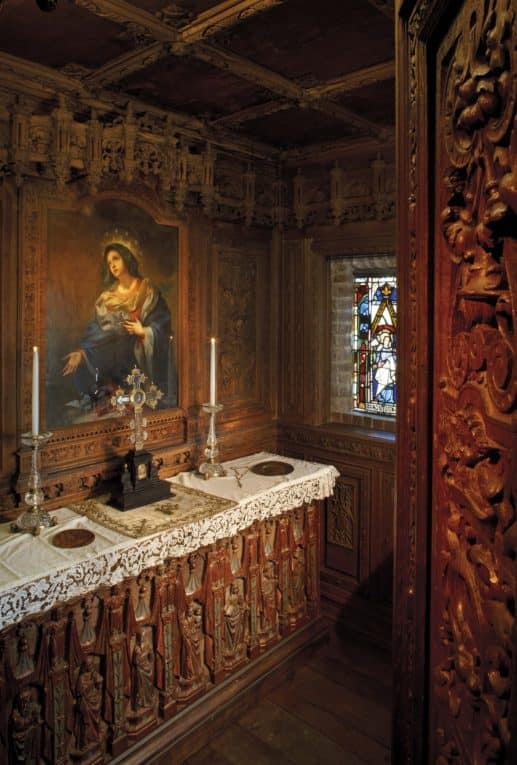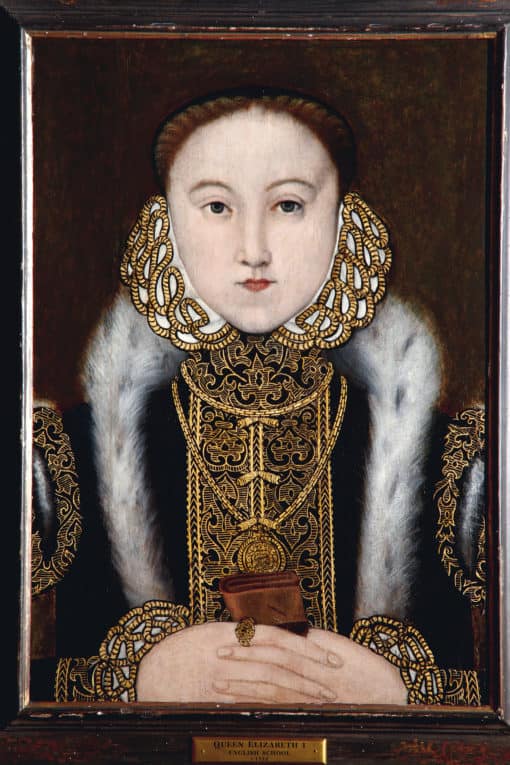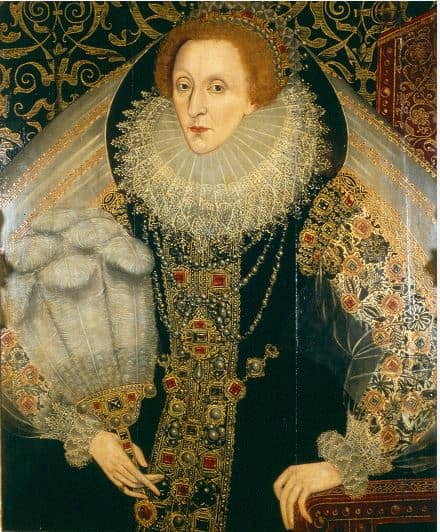

The theme for this week’s #TudorTuesdays with Historic Houses is Elizabeth I.
There are two portraits of Elizabeth I on display at Hever Castle – the childhood home of her mother, Anne Boleyn.
Both are on display in the Staircase Gallery and one is more unusual as it portrays her before she was Queen.

A rare portrait of Elizabeth I before she was Queen
Elizabeth I’s reign reversed the Counter-Reformation of Mary I so the Catholics who had enjoyed freedom under Mary were now forced to conceal themselves.
Among those were the Waldegrave family who had enjoyed power under Mary’s reign with Edward Waldegrave being knighted and given a place on the Privy Council as well as being gifted Hever Castle.
When Elizabeth I took the throne Catholics had to grow adept at concealment, creating spaces within their houses to hide a priest should the authorities come looking. Celebrating Mass had been made illegal by the Act of Uniformity in 1559, and Elizabeth punished those who trained or harboured priests as traitors and not heretics. Those who fell foul of the law faced not the flames but potentially the traitor’s death of hanging, drawing, and quartering.

Visitors to the Waldegrave Room at Hever Castle can see a small chapel, or oratory, which was built after Queen Mary’s death in 1558. Hidden behind panelling, this chamber was built so that Sir Edward could practice his faith in secret, following Elizabeth I ascension to the throne.
Sir Edward Waldegrave’s short respite from persecution was shattered in 1561 when he was arrested in conjunction with a spurious conspiracy, known as the ‘Waldegrave Conspiracy.’
Custom’s officials at Gravesend had seized Waldegrave’s priest, Father John Coxe, who was found with a rosary and letters for Catholic exiles. After interrogation, Sir Edward Waldegrave was named as one of many for whom Coxe had said Mass. Sir Edward Waldegrave was arrested with twenty-two other lay Catholics who were implicated by the confession that Coxe gave, and all were found guilty before the Essex Assize Court on 3rd June 1561. The lay Catholics were ordered to pay a fine of 100 marks – approximately £15,000 in today’s money. Sir Edward Waldegrave refused to pay the fine and he and his wife Frances were taken back to the Tower of London. He did not last long, dying in his cell on 1st September 1561. Frances was released from the Tower upon his death but similarly refused to pay the fine, forfeiting Edward’s manor of Newhall in Essex.
It appears that the mastermind behind the ‘Waldegrave Conspiracy’ was William Cecil, the Queen’s chief advisor, who was determined to prevent Elizabeth from marrying Robert Dudley. He feared that although a Protestant, Dudley would seek support for his marriage from King Philip of Spain and risk conditions laid down on Philip’s part that would return England to Catholicism. Rumours that those accused with Waldegrave were conspiring to kill the Queen created sufficient furore of a Catholic conspiracy to ensure that any marriage plans were thwarted. It is perhaps in this context that the priests accused were only corporally punished – being pilloried twice and then imprisoned – and not subject to capital punishment.
Elizabeth I went onto to become one of the most famous monarchs in British history.
Due to her persecution of the Waldegrave family there is no evidence to suggest she ever visited Hever Castle, though there is evidence that she visited the Sidney’s at Penshurst Place, 3 miles from Hever Castle (Lady Mary Sidney was a particular favourite lady in waiting, she was the sister of Lord Robert Dudley).
Mary Boleyn’s children, Catherine and Henry Carey, also went onto to have successful careers at the court of their cousin, Elizabeth I.
If you enjoyed this item on Elizabeth I then why not discover the previous #TudorTuesdays news items:
• Tudor Chapels
• Tudor Windows
• Tudor Tapestries
• Tudor Chimneys
• Tudor Panelling
• Tudor Knot Gardens
• Tudor Childhood
• Tudor Dining Rooms
• Tudor Rose Gardens
• Henry VII
• Henry VIII
• Mary I
Book your visit to Hever Castle & Gardens.
Within the grounds of the Hever Castle Estate, there are two opportunities for you to stay the night with us.
Hever Castle has played host to many important events and celebrations for over 600 years. In 1903 when William Waldorf Astor set about restoring Hever Castle to its former glory, he added the Astor Wing, to accommodate his family and guests, before creating a lake and the spectacular Italian Garden to house his impressive collection of ancient Greek and Roman statuary.
There are multiple places to eat & drink across the Hever Castle Estate. Select between the Castle & Gardens and Golf Club below to discover more.
Set in the mature grounds of the Hever Castle Estate, Hever Castle Golf Club is a 27 hole Kent golf course that will encourage and inspire all golf enthusiasts.
Set in the mature grounds of the Hever Castle Estate, the Wellbeing Centre consists of five smart treatment rooms.